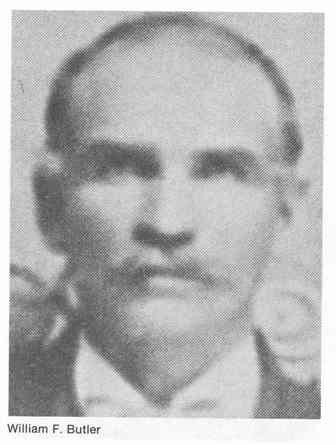
WASHINGTON COUNTY HISTORICAL SOCIETY (Washington County, Utah)
WILLIAM F. BUTLER
(pioneer colonizer, farmer)
BIOGRAPHY
William F. Butler, a farmer by occupation, was representative of many Mormon pioneers who, upon coming to Utah, were "called" by church leaders to move from place to place colonizing and expanding the boundaries of "Zion" in the "Mormon Corridor."William Franklin Butler was born on February 1, 1824, in Spencer, Indiana. He was a son of Abel Butler and Milburn Leitherland Butler.
He married Sarah Ann DeWitt on September 20, 1846.
Butler was converted to the L.D.S. faith and came to the Utah Territory with his growing family of five in 1852. He was immediately called to be in the vanguard party of settlers who established Palmyra, a short-lived town near Utah Lake which was temporarily abandoned in 1855. Like most of his neighbors, Butler moved over to nearby Spanish Fork where he expanded his family by five children and served as a city councilman.
At the Mormon "General Conference" in October 1861, the Butler family was one of 309 families asked by church president Brigham Young to join "a company of missionaries for the south." Anticipating the outbreak of a national civil war, Young expected that the territory's supply of cotton from the southern states might be cut off thereby creating a critical shortage of the important materials. To minimize the impact of this eventuality, Young sent the "company of missionaries" to grow cotton in an arid, sparsely-settled area of southern Utah aptly named Dixie. Here Butler and his fellow colonizers established the city of St. George.
A census taken in the summer of 1862 shows William F. Butler to have been among the city's very first settlers. In January 1862, he was among those who contributed money toward the building of St. George's first public building, a stone school, social hall and meeting house. Of such early donors it was said "not many of these subscribers had a roof over his own head as yet." Apparently somewhat better off than some of his peers, Butler was one of those listed in an 1864 "survey of breadstuffs on hand" to have a surplus of food and cotton, enough to offer some for trade.
The earliest known townsite map of St. George shows that "William F. Buttler" (sic) owned a residential parcel at the northwest corner of 200 South and 300 West streets. This property he obtained by drawing a lot out of a hat as was customary in Mormon communities of the period. On February 15, 1875, after a federal land patent gave legal ownership to the inhabitants of St. George, an abstract was signed and recorded giving Lot 1 on Block 8 Plat A to William F. Butler. It is on this property that the present house is located.
Butler served as a counselor to Bishop Henry Eyring in the St. George Fourth Ward.
He worked as a farmer and in 1875, he became the foreman of the Price City Co-operative Farming Company, a part of the defunct Heberville Co-operative Farming Company. 1875 was also the year that this home was sold to Haden W. Church Jr. The Heberville Company had been a part of the short-lived United Order in that town.
On May 15, 1879, Butler married Katherine Fuchs.
On November 19, 1881, his first wife, Sarah Ann, died.
Butler and his burgeoning family of two wives and many children continued to particpate in the development of St. George until the mid-1880s when the family responded to another "call," this time to the seemingly more inhospitable territory of Arizona. On June 7, 1886, Butler sold his holdings to Henry Gotfreid (Gotfrey) Bryner and moved on to help settle Hubbard, Arizona.
Butler moved to Pima, Arizona, where he died on July 11, 1909.
FAMILY
TBDPHOTOS
Photos on the web:TBD
REFERENCES
William Franklin Butler, I and Sarah Ann Dewitt WebsiteBiography of William Franklin Butler Sr.
by Margaret Butler Shelley, Granddaughter